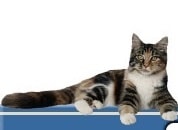


 |
 |
 |
|||||
         |
|
|
Contents
|
|
What's in a wacky pet name?
dvm360 July 2018
Pablo Purrcasso and Isabella Miss Worldwide Boo Boo top Nationwide’s 2018 Wackiest Pet Names lists for cats and dogs, respectively, according to a recent company release. The names were chosen out of Nationwide’s database of more than 700,000 insured pets. As you might expect, there’s more to these names than meets the ear, and these adoring pet owners are happy to share their backstories.
The top 10 wacky cat names of 2018
1. Pablo Purrcasso
2. Sir Pounce a Lot
3. Mewpocalypse Yarn Killer
4. Edward Scissorpaws
5. Sir Reginald Fluffybutt
6. Princess Consuela Bananahammock
7. Bobcat the Builder
8. Colonel Puff Puff
9. Majesticoons Carefree Dior Blue Knight
10. Banana Pawz
The top 10 wacky dog names of 2018
1. Isabella Miss Worldwide Boo Boo
2. Franklin Woofsevelt
3. Ruffy the Vampire Slayer
4. Vladimir Poochin
5. Sir Lix a Lot
6. Chauncey Von Poops a Lot
7. Madame Squishy Van Wrinkleface
8. Lord Stanley the Pup
9. Little Bunny Foo Foo
10. Sylvester Stud Puddin’ Pop |
| Back to Top |
|
Head out for a Hike
DogFancy September 2011
With milder weather, this month is a great time to hit dog-friendly trails with your hiking buddy. Your dog will revel in the sights and smells. Just remember to take along her supplies.
Water: If hiking less than four hours, take one to two water bottles for your dog. Offer water to her every half hour. She’s working hard, too. Don’t risk dehydration and heat stroke.
For longer hikes, take more. Jan Holley, a handler with Rocky Mountain Rescue Dogs (a canine search-and-rescue organization in northern Utah), recommends adding flavored electrolyte powders, that are especially formulated for dogs, to water. "Hydration is a major concern, especially in the summer months."
Water Bowl: Take along a collapsible bowl for dispensing the water. Wash and dry it when you return home.
Leash: Trails usually require leashes. If trail policy allows for off-leash dogs, take one anyway. You’ll need a leash the trailhead because of traffic.
If you don’t entirely trust your dog around people or other dogs, keep her on a leash at all times. It also helps for safety, in case you encounter rattlesnakes, horses, mountain bikers whipping around blind corners, or need to steer her away from poisonous plants.
Doggie Treats: Always, right? Your dog will tell you the same thing.
Plastic Bags: Recycle grocery bags for doggie messes. Considerate cleanup helps keep the trails open to dogs.
First-Aid Kit: Take some first-aid essentials, just in case. Ready-made dog kits are available, or embellish a human kit with items recommended by your veterinarian. You can see a sample canine kit at DogChannel.com/extras.
Doggie Backpack: IF your dog is medium-sized or bigger, consider having her carry her own water and treats. Outfit her with a well-constructed, comfortably snug doggie backpack. Take her to pet supply stores and outdoor recreation outfitters to try on packs before investing.
Dog Booties: If hiking rough terrain or in severe temperatures, purchase a set of booties for your dog. Look for waterproof booties with flexible rubber soles with tread patterns for traction. Size them right for a comfortable fit.
Booties can be used year-round, and you may want them for neighborhood walks on account of salt, ice melt, glass, and hot pavement. |
| Back to Top |
|
Let's Play
Cat Fancy December 2013
There is nothing quite as entertaining as watching cats playing energetically with each other or chasing and batting around objects. Although play is about having fun, it is also serious business – teaching important skills and stimulating cat minds and bodies. Cats play throughout their whole lives, starting when they are about 3 weeks old and extending into their senior years.
Play for All Ages
Play is essential for teaching life skills to kittens. Through play, kittens and youngsters learn the fine art of hunting – stalking, lying in wait and pouncing. It also helps them develop socialization skills, and teaches them boundaries and bite inhibition. Play also hones their motor skills, develops coordination, and builds muscles and strength. And, let’s face it, playing is fun! No excuse is ever needed for having a raucous play session.
Play is also important for adults and seniors, who play, though not with the intensity or frequency as when they were kittens. Play improves their hunting skills, chases away boredom, and is mentally and physically stimulating. Along with other enjoyable cat-centric activities, play strengthens and builds the bonds between cats and their people. It also helps socialize shy felines and encourages them to overcome their fear of people and places. Lively play sessions burn calories and help keep kitties fit.
Geriatric cats also benefit from playing. Specific activities that include a limited amount of play might help decrease the symptoms of feline cognitive dysfunction. The activities can be as simple as the cat tracking the toy with her eyes or reaching to grab a feather as it flitters by. The act of playing, no matter how small, focuses the cat and presents a problem that her mind seeks to solve. It is similar to people doing crossword puzzles to keep their minds active.
Customized Play
Every cat is a unique individual. Age, health and physical condition influence the intensity of the play, the types of activities, and the number of sessions.
Playtime needs for youngsters are different from those of elderly cats. Kittens are little play machines. Everything in their world is a toy that needs to be pounced on and batted around. By definition, kittens need many high-energy play sessions throughout the day. As cats age, their play requirements change. Adults do not cavort as intensely or as often as kittens do. Most adults function well with two play sessions every day, one in the morning and another in the evening when they are typically the most energetic. Cats are crepuscular by nature. This means they are active at dawn and dusk - the–times when cats in the wild typically hunt.
Get the Most Out of Playtime
There are a variety of ways to play with cats, and some are more beneficial than others. The best play methods, in addition to being mentally and physically stimulating, are fun. Here are five tips to help you and your cats get the most out of playing:
|
| Back to Top |
|
Make Nail Trims Easier
DogFancy September 2011
True or false?
All of these statements are false!
"Many owners are afraid of clipping their dog's nails and catching the quick growing inside the dog's nail," says Lisa Reeder, master groomer at Stylin' Pets Boutique and Spa in Logan, Utah. Take your time to either see (easiest if your dog has white nails), or feel the quick. "Use your nail clippers to rub the underside of the nail," Reeder says. "The quick will be smooth to the clipper, but then when you have passed the quick, the nail will go jagged and catch your clippers." Clip just below where the jagged edge begins. Once you have made the clip, Reeder suggests examining the nail. A white-and-black circle may indicate the beginning of the quick.
"The key is to cut small amounts off and build your confidence," Reeder says. "The quick does grow with the nail over time, so if you haven't cut recently, don't take a big piece off."
Nail trimming is a life-long grooming task for dog owners. "There's a dangerous misconception afloat that you can trim a nail back far enough and cauterize so you won't have to trim again, but such a procedure is neither safe nor effective," says Kimberly Coyner, DVM, a diplomate of the American College of Veterinary Dermatologists, with the Dermatology Clinic for Animals of Las Vegas. Instead of looking for quick fixes (pun intended!), Coyner highlights the need for owners to begin gently handling their pup's paws and trimming just the nailtips at a young age, with plenty of praise and treats. |
| Back to Top |
|
Did you know cats hate scented Litter?
CatFancy December 2013
The American Association of Feline Practitioners and Cornell Feline Health Center Cornell University College of Veterinary Medicine states that most cats prefer non-scented litter. Because your cat's sense of smell is 1000 times stronger than yours, what seems like a little perfume to you is actually overwhelming and stressful to your cat. Unfortunately, most of today's cat litters are scented with perfumes to cover up litter box odors. |
| Back to Top |
